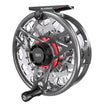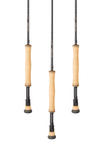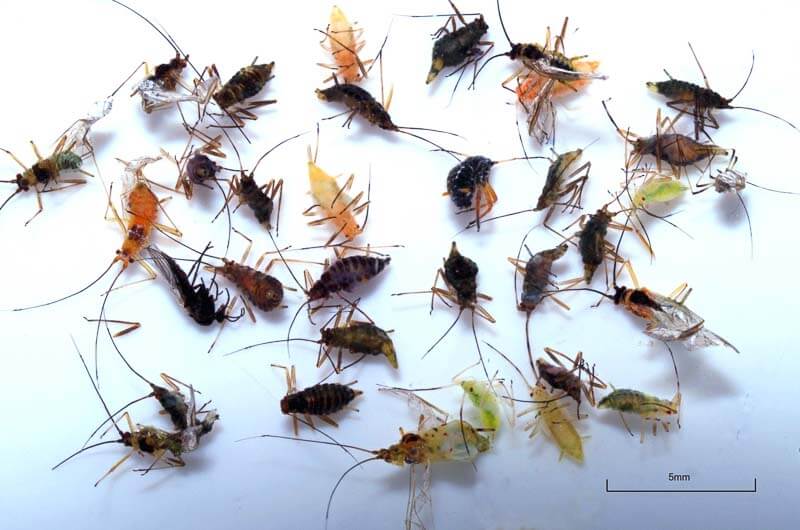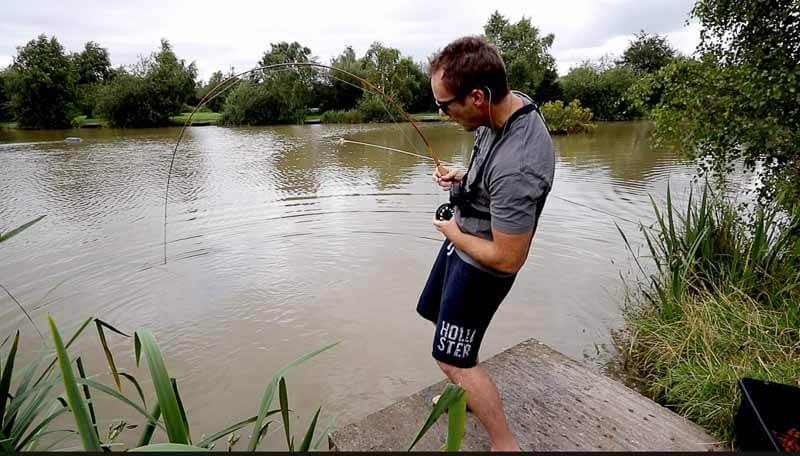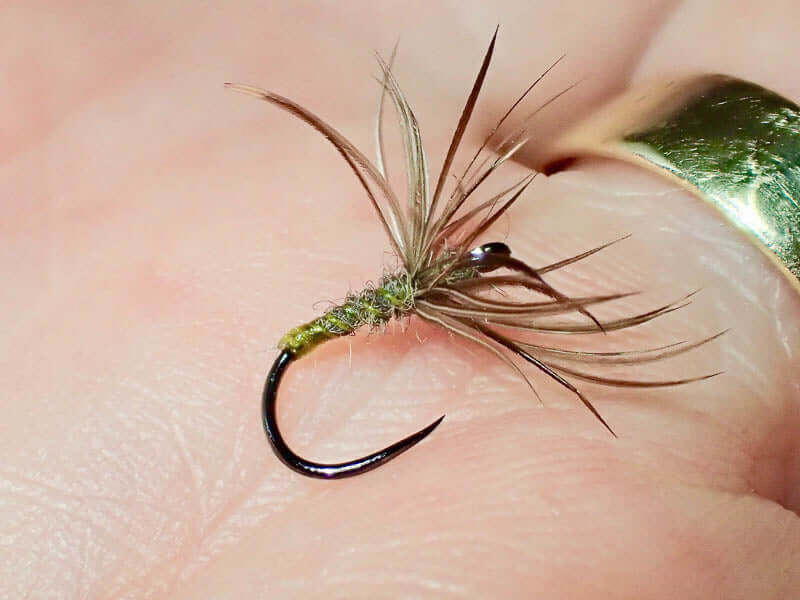Grayling Flies | Fishing for Grayling with Aphids
Trout and grayling can become totally preoccupied on any super-abundant tiny food source to the exclusion of all else. These include Caenis spinners, Chironomid Midges (particularly adults and pupae), Thrips (Thunderbugs), Agapetus sedge pupae and particularly Aphids. At such times it is usually essential to fish an appropriately small fly pattern with an appropriate presentation.
There are at least 600 species of aphid in the UK and most are quite species specific with regard to the plants on which they feed. All species are very small, generally from 2 to 5mm long. Colours range through black, brown, green, yellow and orange. Winter is usually spent as cold-resistant eggs often on the buds of the host plant. There are two adult life stages: in spring the eggs hatch to produce mainly wingless females that reproduce by parthenogenesis (asexual, with no need to mate) and population numbers can explode early in the year. The offspring, which are all clones of the parent, are live-born (no eggs). Aphids feed by piercing the host plant’s food-carrying tubes (phloem) in the stems or leaves with their hollow mouthparts. The pressure within the phloem is such that sugary sap is forced into the aphid’s stomach and not all of this is absorbed, some is released as ‘honey dew’ from the aphid’s anus. Ants often feed on this sugary waste and cars parked under trees with heavy aphid populations get covered with sticky droplets. In late summer and autumn (into November) a winged adult stage appears with both males and females. These mate, in order to achieve genetic variation and then lay eggs that survive the cold of winter.
Sycamore trees, common along the banks of many of our rivers, are a great source of aphids, hosting at least 8 species and it is primarily in areas of river where sycamores are abundant that I search for aphid-feeders. Alder trees, common along the banks of many rivers also support good aphid populations & 7 species have been identified on the Common European Alder. The best times to find aphids on the water are windy days from mid May and throughout the summer, but the main glut as far as the fish are concerned is often at leaf-fall and when the winged adults are in flight during October and November. Let me recount some classic examples of top-notch dry fly fishing for aphid-feeders.
Trout Fishing
The first was a day in mid May, a few years ago, on Pickering Beck in North Yorkshire. The river was swollen and badly coloured after heavy overnight rain and it was blowing a gale. Why I chose to go fishing on such a wild day I’ll never know. On seeing the river I nearly returned home but fortunately I saw a fish rise in a tiny bankside eddy and decided to look above the mill weir where the water is slow and deep. The river surface was covered with debris, branches and masses of fresh, young leaves that had been ripped off the overhanging alder trees by the gale. Trout were rising steadily despite the heavily coloured water and a close inspection of some of the leaves showed them to be covered with tiny green aphids. Dodging the falling branches and with great difficulty because of the gusting wind I cast my size 24 CdC IOBO Humpy to the rising fish and in a relatively short time I’d landed around 20 feisty little wild brown trout. It was a great fishing session all thanks to the gale and the aphids.
The second instance was a couple of days in mid November 2018 on an industrial Yorkshire river that has a good number of sycamore trees along its banks. The weather was remarkably mild and leaf-fall was well underway. On arrival fish were rising steadily and in big numbers along a glide next to where we’d parked the car. The river surface was covered with leaves and there were a huge number of aphids drifting down in the surface film. Stuart Crofts, Steve Donohue and I had an absolute bonanza with the Winter grayling. We fished with a range of size 24 to 30 dry flies. Hook size proved to be a critical factor. Having started with a rather overdressed short-shank size 24 CdC IOBO Humpy I found that I was getting far fewer takes than I had anticipated and was missing quite a few of the takes that I got. A change to a size 30 short-shank CdC Minimalistic Micro Midge immediately increased both the number of takes and successful hook-ups.
May & June 2019 was a time when the fish on my local rivers were often totally focused on Aphids, totally ignoring the Olives & Mayflies; friends reported similarly from many other parts of the country. The big challenge for me was that the fish were mainly feeding in slow, shallow glides & the waters were desperately low & clear. Furthermore on several windy days the river surface was littered with leafy debris (bits of leaf, leaf buds & sycamore flowers) which made seeing a size 24 to 30 imitation difficult & resulted in debris sticking to the hook if the fly wasn’t taken virtually instantly (before an drag set in).
I’ve said it before and I’ll say it again; “accurate casting and good presentation are critical if success is to be achieved when fishing with tiny flies”. Fish will usually not move any significant distance when feeding on tiny organisms as it’s just not energy-efficient. Aphids resting on or trapped in the surface-film dead-drift, so any imitation must not suffer from even the slightest micro-drag if it is to look natural. Whilst trout will sometimes take an imitation as it starts to drag, grayling will normally reject a fly with even the slightest unnatural movement. To achieve a perfectly drag-free drift is very difficult and repeated attempts may be necessary to achieve success. The following will improve the angler’s chance of achieving the perfect drift:
· Use long flexible (light) tippet (I use at least 5’ of 0.09mm copolymer).
· Tie your fly into a loop knot (Rapala Knot, Fordyce Loop or Perfection Loop) to give it free movement from the relatively stiff tippet.
· Use a flexible tapered leader (I use 7’ of copolymer tapering from 0.43mm to 0.20mm diameter, but furled leaders are even more flexible).
· Use as light/thin/flexible a fly line as possible (I usually use a Micro Nymph, 0 weight or a 1 weight Jeremy Lucas micro thin delicate presentation line with its long front taper). You could consider using a silk line as they are far more flexible than plastic coated lines, however with long rods they have a habit of wrapping around the rod tip, as do long furled leaders and this can be a nuisance when wading.
· Use a suitable slack line cast so that there is some slack in the line, particularly at the tippet end. You don’t want a perfectly straight line between rod tip and fly as this will allow the instant onset of drag. The Italian Style Slowed Down Angular Cast is perfect for putting slack into the leader and tippet whilst keeping the main line off any rogue currents.
· If possible cast across and slightly downstream with a dump/slack-line cast and an upstream reach, then track the rod tip downstream at the same pace as the current. Using a long rod will help with this such as the Sunray ZERO at its 10’ 6” configuration or the Sunray Volition 10’ 2 weight.
The above things will reduce the effects of rogue currents pulling and pushing on the line and the last one will also ensure that the first thing the fish sees is the fly and not the line.
So what about fly patterns and hooks? Firstly, as mentioned earlier, there are times when size is critical. The more intense the rise, when aphids are super-abundant, the more important it is to have a really small fly. I keep reading about size 18 and 20 hooks used for aphid patterns, but as you’ll see from Stuart Croft’s photo of a grayling’s stomach contents aphids are only about 3mm long and a size 30 short shank hook is more suitable for tying life-size imitations. There are very few really small hooks available to the fly tier and some are in my opinion not strong enough, whilst others have eyes that are far too small. My favourite hooks are Tiemco 2488s (which need the micro-barb flattening and appears now to be only made down to size 26) and Gamakatsu C12-BM (barbless and with the advantage of having a big eye). Unfortunately Tiemco 2488 hooks are impossible to purchase in small sizes in the UK and are very expensive when sourced from the USA, however the Gamakatsu hooks are now available from Deer Creek. Other small hooks available in the UK are the Daiichi 1110 and Orvis Big Eye Dry Fly hooks which are identical and are made down to size 26 (the same length as a size 24 Tiemco 2488): their big eye is an advantage but the gape is a bit narrow for my liking and the barbs need to be flattened.
My pattern for aphids and midges is very simple. In size 24 I usually tie my variant of Jack Tucker’s deadly pattern, the CdC IOBO (It Oughta Be Outlawed) Humpy. Below size 24 I tie my own Minimalistic Micro-Midge, which is just the tip of a CdC feather tied facing over the hook eye. The example in the photo has no wing at the back but if I want extra visibility and buoyancy I leave a bit of feather butt extending over the back of the hook shank. I generally tie these flies with tan 8/0 thread and natural greyish/tan Mallard CdC. To aid visibility if I’m fishing with a light background I treat the CdC with a thin coating of Roman Moser Miracle Float gel, whilst if the background is dark I apply white Fumed Silica Powder. As you’ll see from the stomach contents photo aphids come in a range of colours and flies tied with orange, yellow or even pink CdC work equally well if you need to improve the visibility. When accurately casting at relatively short range I find that I have no problem seeing these miniscule flies (fishing at distances over 30’ becomes counterproductive due to the reduced casting accuracy and the reduced hooking rate).

1. Aphids from a grayling stomach sample (photo by Stuart Crofts)

2. Size 30 IOBO Humpy against a mm scale, the size of a real aphid! (Gamakatsu C12-BM hook)

3. An autumn grayling that fell to a size 30 CdC fly

4. A wild brown trout that fell for a size 24 IOBO Humpy when the only surface
flies were aphids on a breezy early summer day






